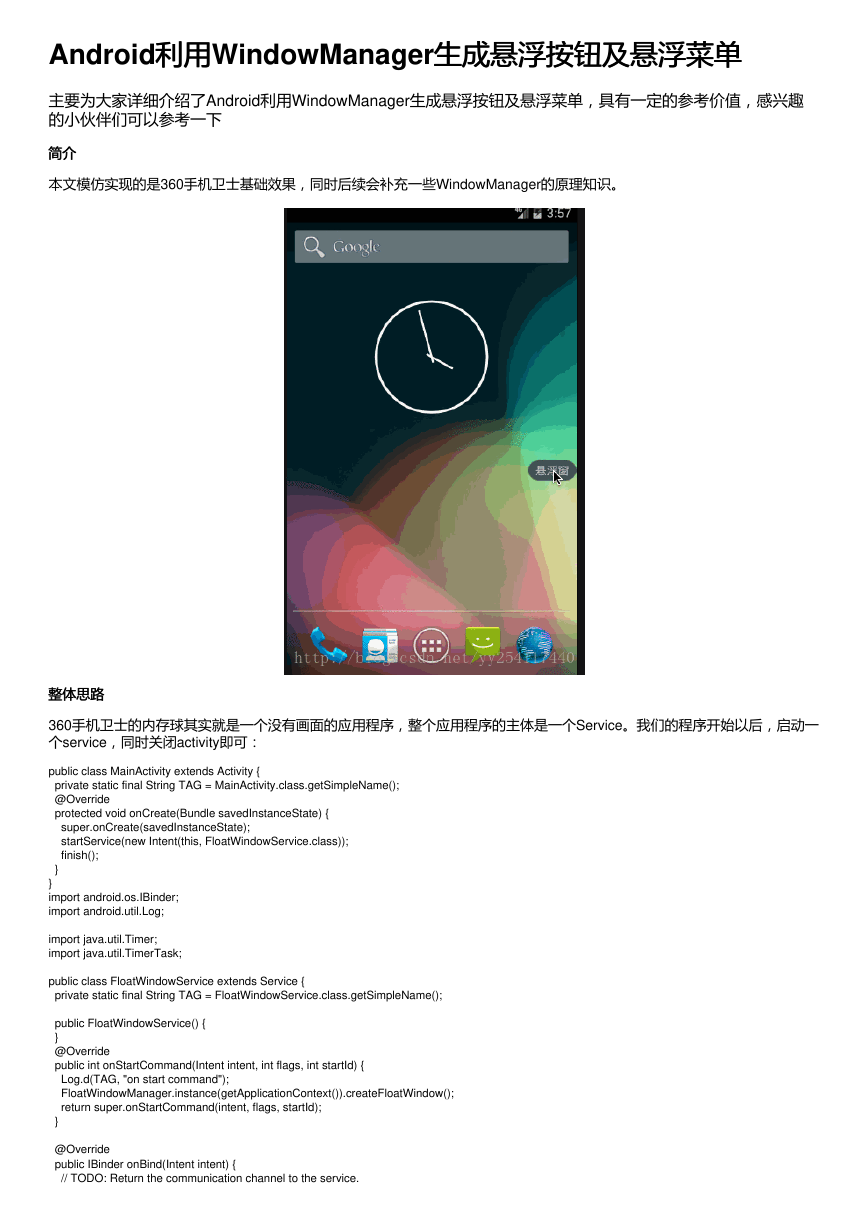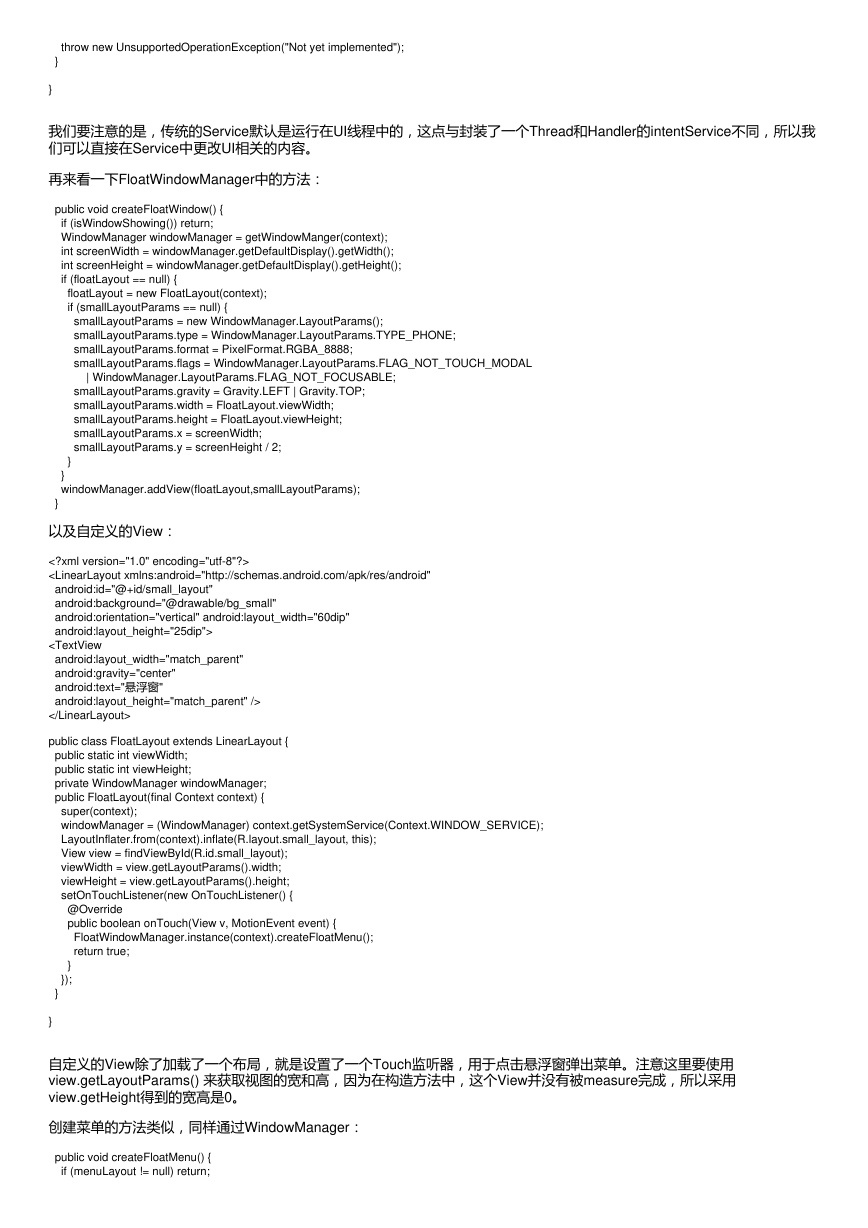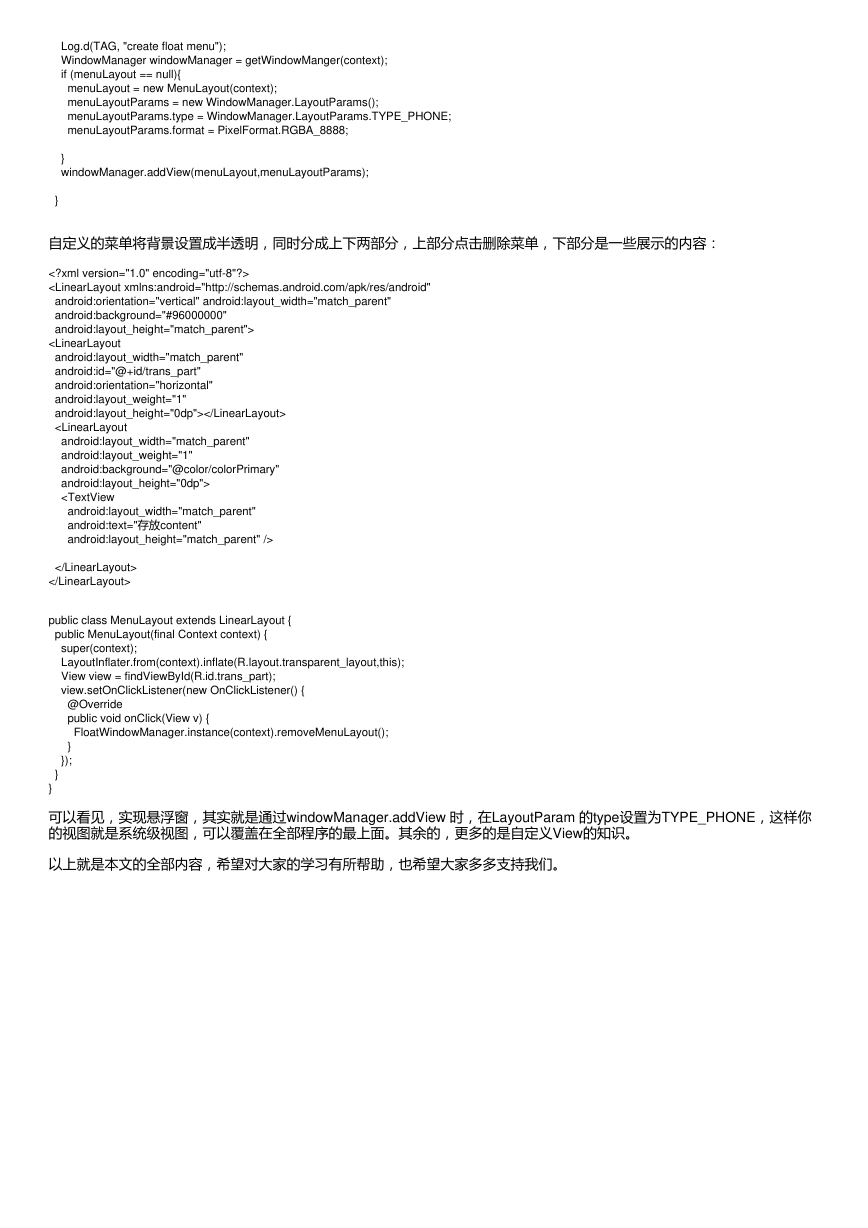Android利用利用WindowManager生成悬浮按钮及悬浮菜单
生成悬浮按钮及悬浮菜单
主要为大家详细介绍了Android利用WindowManager生成悬浮按钮及悬浮菜单,具有一定的参考价值,感兴趣
的小伙伴们可以参考一下
简介简介
本文模仿实现的是360手机卫士基础效果,同时后续会补充一些WindowManager的原理知识。
整体思路
整体思路
360手机卫士的内存球其实就是一个没有画面的应用程序,整个应用程序的主体是一个Service。我们的程序开始以后,启动一
个service,同时关闭activity即可:
public class MainActivity extends Activity {
private static final String TAG = MainActivity.class.getSimpleName();
@Override
protected void onCreate(Bundle savedInstanceState) {
super.onCreate(savedInstanceState);
startService(new Intent(this, FloatWindowService.class));
finish();
}
}
import android.os.IBinder;
import android.util.Log;
import java.util.Timer;
import java.util.TimerTask;
public class FloatWindowService extends Service {
private static final String TAG = FloatWindowService.class.getSimpleName();
public FloatWindowService() {
}
@Override
public int onStartCommand(Intent intent, int flags, int startId) {
Log.d(TAG, "on start command");
FloatWindowManager.instance(getApplicationContext()).createFloatWindow();
return super.onStartCommand(intent, flags, startId);
}
@Override
public IBinder onBind(Intent intent) {
// TODO: Return the communication channel to the service.
�
throw new UnsupportedOperationException("Not yet implemented");
}
}
我们要注意的是,传统的Service默认是运行在UI线程中的,这点与封装了一个Thread和Handler的intentService不同,所以我
们可以直接在Service中更改UI相关的内容。
再来看一下FloatWindowManager中的方法:
public void createFloatWindow() {
if (isWindowShowing()) return;
WindowManager windowManager = getWindowManger(context);
int screenWidth = windowManager.getDefaultDisplay().getWidth();
int screenHeight = windowManager.getDefaultDisplay().getHeight();
if (floatLayout == null) {
floatLayout = new FloatLayout(context);
if (smallLayoutParams == null) {
smallLayoutParams = new WindowManager.LayoutParams();
smallLayoutParams.type = WindowManager.LayoutParams.TYPE_PHONE;
smallLayoutParams.format = PixelFormat.RGBA_8888;
smallLayoutParams.flags = WindowManager.LayoutParams.FLAG_NOT_TOUCH_MODAL
| WindowManager.LayoutParams.FLAG_NOT_FOCUSABLE;
smallLayoutParams.gravity = Gravity.LEFT | Gravity.TOP;
smallLayoutParams.width = FloatLayout.viewWidth;
smallLayoutParams.height = FloatLayout.viewHeight;
smallLayoutParams.x = screenWidth;
smallLayoutParams.y = screenHeight / 2;
}
}
windowManager.addView(floatLayout,smallLayoutParams);
}
以及自定义的View:
public class FloatLayout extends LinearLayout {
public static int viewWidth;
public static int viewHeight;
private WindowManager windowManager;
public FloatLayout(final Context context) {
super(context);
windowManager = (WindowManager) context.getSystemService(Context.WINDOW_SERVICE);
LayoutInflater.from(context).inflate(R.layout.small_layout, this);
View view = findViewById(R.id.small_layout);
viewWidth = view.getLayoutParams().width;
viewHeight = view.getLayoutParams().height;
setOnTouchListener(new OnTouchListener() {
@Override
public boolean onTouch(View v, MotionEvent event) {
FloatWindowManager.instance(context).createFloatMenu();
return true;
}
});
}
}
自定义的View除了加载了一个布局,就是设置了一个Touch监听器,用于点击悬浮窗弹出菜单。注意这里要使用
view.getLayoutParams() 来获取视图的宽和高,因为在构造方法中,这个View并没有被measure完成,所以采用
view.getHeight得到的宽高是0。
创建菜单的方法类似,同样通过WindowManager:
public void createFloatMenu() {
if (menuLayout != null) return;
�
Log.d(TAG, "create float menu");
WindowManager windowManager = getWindowManger(context);
if (menuLayout == null){
menuLayout = new MenuLayout(context);
menuLayoutParams = new WindowManager.LayoutParams();
menuLayoutParams.type = WindowManager.LayoutParams.TYPE_PHONE;
menuLayoutParams.format = PixelFormat.RGBA_8888;
}
windowManager.addView(menuLayout,menuLayoutParams);
}
自定义的菜单将背景设置成半透明,同时分成上下两部分,上部分点击删除菜单,下部分是一些展示的内容:
public class MenuLayout extends LinearLayout {
public MenuLayout(final Context context) {
super(context);
LayoutInflater.from(context).inflate(R.layout.transparent_layout,this);
View view = findViewById(R.id.trans_part);
view.setOnClickListener(new OnClickListener() {
@Override
public void onClick(View v) {
FloatWindowManager.instance(context).removeMenuLayout();
}
});
}
}
可以看见,实现悬浮窗,其实就是通过windowManager.addView 时,在LayoutParam 的type设置为TYPE_PHONE,这样你
的视图就是系统级视图,可以覆盖在全部程序的最上面。其余的,更多的是自定义View的知识。
以上就是本文的全部内容,希望对大家的学习有所帮助,也希望大家多多支持我们。
�






 2023年江西萍乡中考道德与法治真题及答案.doc
2023年江西萍乡中考道德与法治真题及答案.doc 2012年重庆南川中考生物真题及答案.doc
2012年重庆南川中考生物真题及答案.doc 2013年江西师范大学地理学综合及文艺理论基础考研真题.doc
2013年江西师范大学地理学综合及文艺理论基础考研真题.doc 2020年四川甘孜小升初语文真题及答案I卷.doc
2020年四川甘孜小升初语文真题及答案I卷.doc 2020年注册岩土工程师专业基础考试真题及答案.doc
2020年注册岩土工程师专业基础考试真题及答案.doc 2023-2024学年福建省厦门市九年级上学期数学月考试题及答案.doc
2023-2024学年福建省厦门市九年级上学期数学月考试题及答案.doc 2021-2022学年辽宁省沈阳市大东区九年级上学期语文期末试题及答案.doc
2021-2022学年辽宁省沈阳市大东区九年级上学期语文期末试题及答案.doc 2022-2023学年北京东城区初三第一学期物理期末试卷及答案.doc
2022-2023学年北京东城区初三第一学期物理期末试卷及答案.doc 2018上半年江西教师资格初中地理学科知识与教学能力真题及答案.doc
2018上半年江西教师资格初中地理学科知识与教学能力真题及答案.doc 2012年河北国家公务员申论考试真题及答案-省级.doc
2012年河北国家公务员申论考试真题及答案-省级.doc 2020-2021学年江苏省扬州市江都区邵樊片九年级上学期数学第一次质量检测试题及答案.doc
2020-2021学年江苏省扬州市江都区邵樊片九年级上学期数学第一次质量检测试题及答案.doc 2022下半年黑龙江教师资格证中学综合素质真题及答案.doc
2022下半年黑龙江教师资格证中学综合素质真题及答案.doc